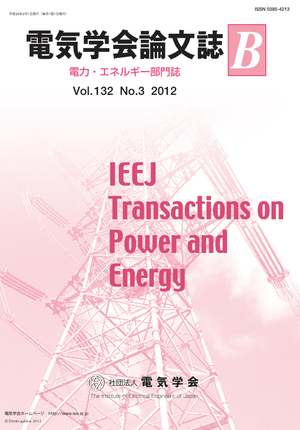1/√N則によるアンサンブル平均日射変動の標準偏差算定に適した地理的範囲
1/√N則によるアンサンブル平均日射変動の標準偏差算定に適した地理的範囲
カテゴリ: 論文誌(論文単位)
グループ名: 【B】電力・エネルギー部門
発行日: 2012/03/01
タイトル(英語): Geographical Extent Feasible for Standard Deviation Calculation using 1/√N Rule regarding Ensemble Average Insolation Fluctuation
著者名: 加藤 丈佳(名古屋大学大学院工学研究科電子情報システム専攻),井上 貴人(名古屋大学大学院工学研究科電子情報システム専攻),本田 信行(中部電力技術開発本部電力技術研究所),小相澤 政和(中部電力技術開発本部電力技術研究所),西野 慎一(中部電力技術開発本部電力技術研究所),鈴置 保雄(名古屋大学大学院工学研究科電子情報システム専攻)
著者名(英語): Takeyoshi Kato (Dept. of Electrical Eng. and Comp. Sci., Grad. School of Eng., Nagoya University), Takato Inoue (Dept. of Electrical Eng. and Comp. Sci., Grad. School of Eng., Nagoya University), Nobuyuki Honda (Electric Power Research & Development Center, Chubu Electric Power Co., Inc.), Kazumasa Koaizawa (Electric Power Research & Development Center, Chubu Electric Power Co., Inc.), Shinichi Nishino (Electric Power Research & Development Center, Chubu Electric Power Co., Inc.), Yasuo Suzuoki (Dept. of Electrical Eng. and Comp. Sci., Grad. School of Eng., Nagoya University)
キーワード: 太陽光発電,日射変動,平滑化効果,標準偏差,中心極限定理 photovoltaic power generation,insolation fluctuation,smoothing effect,standard deviation,central limit theorem
要約(英語): In this study, we evaluated the practical usability of so-called 1/√N rule, focusing on three factors, i.e. the geographical extent, the location of representative point, and the topological difference. First, by using the insolation data observed at 37 points mainly located in the Nobi Plain, we calculated the correlation diagram between two different standard deviations (STDs) of geographical average insolation fluctuation, i.e. STD of ensemble average insolation of N points (σe) and STD calculated with the representative point data by using 1/√N rule (σN). As the results of evaluating the slope and R2 values of regression line of correlation diagram and the P-value of χ2-test regarding frequency distribution of σe and σN, the 1/√N rule would be applicable for the area of around 20km radius. The representative point for calculating σN should be carefully selected even within the area of 15km radius. Because the difference in weather condition is much larger in the Matsumoto Basin area than in the Nobi Plain area even if the area size is the same, the 1/√N rule should be applied to smaller area than the area of 20km radius available for the Nobi Plain area.
本誌: 電気学会論文誌B(電力・エネルギー部門誌) Vol.132 No.3 (2012)
本誌掲載ページ: 213-219 p
原稿種別: 論文/日本語
電子版へのリンク: https://www.jstage.jst.go.jp/article/ieejpes/132/3/132_3_213/_article/-char/ja/
受取状況を読み込めませんでした


